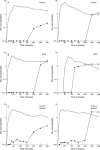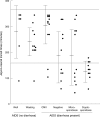Small intestinal transit, absorption, and permeability in patients with AIDS with and without diarrhoea
- PMID: 10369707
- PMCID: PMC1727572
- DOI: 10.1136/gut.45.1.70
Small intestinal transit, absorption, and permeability in patients with AIDS with and without diarrhoea
Abstract
Background: Diarrhoea in AIDS is associated with anorexia and weight loss. The importance of gastrointestinal transit in such symptoms has not been addressed.
Aims: To assess jejunal to caecal transit times in subjects with AIDS related diarrhoea and weight loss and correlate these with measures of absorptive capacity and intestinal permeability.
Methods: Jejunal to caecal transit times were assessed in 20 seronegative controls and 60 HIV seropositive subjects from serum analysis of 3-O-methyl-D-glucose and sulphapyridine after ingestion of the monosaccharide and sulphasalazine in aqueous solution. The method also allows an estimation of gastric emptying times for liquids. Intestinal absorptive capacity and permeability were assessed by a combined test using 3-O-methyl-D-glucose, D-xylose, L-rhamnose, and lactulose.
Results: Gastric emptying was significantly delayed in all groups of patients with AIDS. Mean jejunal to caecal transit times were not significantly different between controls (246 (62) minutes) and patients without diarrhoea (AIDS, well: 278 (103) minutes; AIDS, wasting: 236 (68) minutes), cytomegalovirus colitis (289 (83) minutes), pathogen negative diarrhoea (192 (100) minutes), or microsporidiosis (190 (113) minutes), although 30% of patients had values below the control range. Patients with cryptosporidiosis differed significantly from controls (135 (35) minutes, p<0.0001), seven of 10 having rapid transit times. Absorptive capacity was reduced and intestinal permeability significantly increased in AIDS, but did not correlate significantly with transit times.
Conclusion: Small bowel transit is accelerated in many patients with AIDS, particularily in protozoal diarrhoea, but is not the sole explanation for malabsorption of monosaccharides.
Figures


References
Publication types
MeSH terms
LinkOut - more resources
Full Text Sources
Other Literature Sources
Medical
